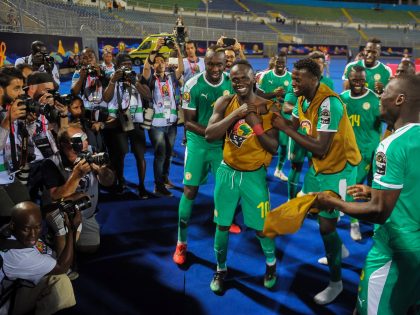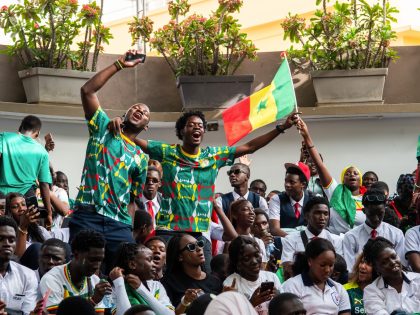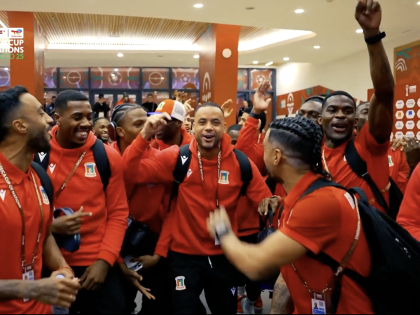The technological circuits of the African diaspora
Given this history of Black dispersal and displacement, what might a liberatory mobility look like?

Marshall Trammell of Black Spirituals. Images credit: Kaleb Welch.
It is an exciting moment for Afrofuturism: the otherworldly Janelle Monáe is lauded as a music and style icon; antiracist activists turn to the oeuvre of Octavia Butler for inspiration; and science fiction from the African continent enjoys international circulation. And at a deeply distressing conjuncture when Black life is so visibly and aggressively under siege, thinking about the future is no less than a matter of survival for Black folk across the diaspora. Many writers and theorists of Black and POC speculative fiction have suggested that racism, abduction, enslavement, experimentation, colonization, and imperialism are all actually the metaphorized stuff of the sci-fi genre. Yet too often, hegemonic visions of the future—whether utopian or dystopian, 20-minutes into the future satires or sweeping space operas—leave little room for difference.
The third-annual Matatu Festival of Stories in Oakland, CA, while not explicitly a festival of Afrofuturism, explored the relationship between Blackness and the future across artistic genres, during its run from September 23rd to 26th, 2015. What are the technological circuits of the African diaspora? How can we think of this diaspora as not just a geographical relationship predicated on traumatic dispersal, but also as a temporal relationship—one that weaves together past and present with hopes and dreams of possible futures? And given this history of Black dispersal and displacement, what might a liberatory mobility look like?

While matters of the imagination, these questions are of critical importance to Black people in Oakland. After decades of racialized disinvestment, the city has come to be hailed as a site of economic, cultural, and technological innovation. Its boosters celebrate this transformation in terms of the now-familiar language of urban “renaissance”—a trope that has signaled, since the time of its referent, the European Renaissance, a techno-utopian vision of the future as salvation. But long-time residents are rightfully suspicious of the way that such narratives treat the time before the after as a “dark age,” serving as a form of cultural whiteout that is the symbolic counterpart of physical displacement. Indeed, since 1990, while it has come to be celebrated as the “most diverse city” in the country, Oakland has lost over 54,000 (one third) of its Black residents.
The visionaries behind Matatu, however, refuse to cede the narrative of renaissance to those who would write Black people and cultures out of the next chapter in the evolution of this embattled city. If Oakland is to have a dynamic future, they seem to argue, it will be because it is still home to the disenfranchised communities of color that have long created “disruptive” innovations in consciousness, making it a “global city” with or without new tech companies like Uber.
On opening night, performance artist Saul Williams took whitewashed techno-utopianism to task with a rousing performance of spoken word poetry from his new collection US(a.) and songs from his concept album MartyrLoserKing. His a cappella chant of the thumping anthem Burundi (“I’m a hacker in your hard drive; I’m a virus in your system”) took on special significance in the Bay Area, where the language of hacking is regularly invoked by millionaire wunderkinder to circumvent the messy baggage of structural oppression with quick-and-easy techno-fixes. Instead, Williams went on to compare the Middle Passage to the Internet and encouraged the audience to “hack” into the powerful networks that classify, incarcerate, and exploit black bodies and minds in the twenty-first century.
Williams appeared alongside local experimental music duo Black Spirituals, a meeting of electronic sound artist Zachary Watkins and percussionist Marshall Trammell that defies categorization. Merging the improvisational solos typical of jazz with dense layers of electronic frequencies and hard-edged noise, the band unleashed generative soundscapes that emerged from and, just as suddenly, descended back into raucous cacophony. But as with any cutting edge, theirs was a form of “disruption” built on tremendous respect for earlier languages of sound. Later in the week, Trammell appeared again, this time with master percussionists Donald Robinson, Tacuma King, and Spirit in the first iteration of a project called “DEMOCRATICS: Decolonizing the Imagination.” Holding an improvisational dialogue between his rock-n-roll kit and the djembes, symbols, and singing bowls of his collaborators, Trammell communed with elder musicians in a lab of linguistic experimentation through the diasporic technology of the drum.
Williams and Black Spirituals followed Necktie Youth, a new film by 23-year-old South African director Sibs Shongwe-La Mer. Necktie merges a stark, almost documentarian take on upper-middle class suburban ennui with a broader, national story of youth disaffection in post-apartheid, post-Mandela, and post-“rainbow” South Africa. It follows a multiracial group of affluent early-twenty-somethings as they drift between drug-, booze-, and sex-fueled parties in the wake of the live-streamed suicide of their friend Emily. The ubiquity of technologically-mediated encounters marks betrayed promises of transcendence in the face of the stubborn recalcitrance of old and new social divisions based on race, class, geography, and mobility. While the film is firmly rooted in the geographies of contemporary Johannesburg, rendered strikingly in high-contrast black-and-white photography, it also speaks to the broader contradictions of our moment: the naive hopes we place upon the shoulders of our hyper-connected millennials, and our creeping suspicions that we’ve missed our window for revolution.

There were clear resonances between Necktie and the festival’s final offering, Black President, the debut film by South African musician-turned-director Mpumelelo Mcata. President profiles the visual and performance art of Zimbabwean-born artist Kudzanai Chiurai, who has courted controversy by relentlessly questioning what is “post” about the “post-colonial” political regimes in Southern Africa. Chiurai’s piercing insights and images—which, for all of their hyperbole, are no less close to life—remind us that undemocratic narratives of salvation and renewal can be authored by Black and White elites alike. And the potential for writing the poor and political dissidents into the margins in the name of a future-oriented “renaissance” is just as high.



















